Subba Reddy Oota
Instruction-Tuned Video-Audio Models Elucidate Functional Specialization in the Brain
Jun 09, 2025Abstract:Recent voxel-wise multimodal brain encoding studies have shown that multimodal large language models (MLLMs) exhibit a higher degree of brain alignment compared to unimodal models in both unimodal and multimodal stimulus settings. More recently, instruction-tuned multimodal models have shown to generate task-specific representations that align strongly with brain activity. However, prior work evaluating the brain alignment of MLLMs has primarily focused on unimodal settings or relied on non-instruction-tuned multimodal models for multimodal stimuli. To address this gap, we investigated brain alignment, that is, measuring the degree of predictivity of neural activity recorded while participants were watching naturalistic movies (video along with audio) with representations derived from MLLMs. We utilized instruction-specific embeddings from six video and two audio instruction-tuned MLLMs. Experiments with 13 video task-specific instructions show that instruction-tuned video MLLMs significantly outperform non-instruction-tuned multimodal (by 15%) and unimodal models (by 20%). Our evaluation of MLLMs for both video and audio tasks using language-guided instructions shows clear disentanglement in task-specific representations from MLLMs, leading to precise differentiation of multimodal functional processing in the brain. We also find that MLLM layers align hierarchically with the brain, with early sensory areas showing strong alignment with early layers, while higher-level visual and language regions align more with middle to late layers. These findings provide clear evidence for the role of task-specific instructions in improving the alignment between brain activity and MLLMs, and open new avenues for mapping joint information processing in both the systems. We make the code publicly available [https://github.com/subbareddy248/mllm_videos].
Correlating instruction-tuning (in multimodal models) with vision-language processing (in the brain)
May 26, 2025Abstract:Transformer-based language models, though not explicitly trained to mimic brain recordings, have demonstrated surprising alignment with brain activity. Progress in these models-through increased size, instruction-tuning, and multimodality-has led to better representational alignment with neural data. Recently, a new class of instruction-tuned multimodal LLMs (MLLMs) have emerged, showing remarkable zero-shot capabilities in open-ended multimodal vision tasks. However, it is unknown whether MLLMs, when prompted with natural instructions, lead to better brain alignment and effectively capture instruction-specific representations. To address this, we first investigate brain alignment, i.e., measuring the degree of predictivity of neural visual activity using text output response embeddings from MLLMs as participants engage in watching natural scenes. Experiments with 10 different instructions show that MLLMs exhibit significantly better brain alignment than vision-only models and perform comparably to non-instruction-tuned multimodal models like CLIP. We also find that while these MLLMs are effective at generating high-quality responses suitable to the task-specific instructions, not all instructions are relevant for brain alignment. Further, by varying instructions, we make the MLLMs encode instruction-specific visual concepts related to the input image. This analysis shows that MLLMs effectively capture count-related and recognition-related concepts, demonstrating strong alignment with brain activity. Notably, the majority of the explained variance of the brain encoding models is shared between MLLM embeddings of image captioning and other instructions. These results suggest that enhancing MLLMs' ability to capture task-specific information could lead to better differentiation between various types of instructions, and thereby improving their precision in predicting brain responses.
* 30 pages, 22 figures, The Thirteenth International Conference on Learning Representations, ICLR-2025, Singapore. https://openreview.net/pdf?id=xkgfLXZ4e0
Multi-modal brain encoding models for multi-modal stimuli
May 26, 2025Abstract:Despite participants engaging in unimodal stimuli, such as watching images or silent videos, recent work has demonstrated that multi-modal Transformer models can predict visual brain activity impressively well, even with incongruent modality representations. This raises the question of how accurately these multi-modal models can predict brain activity when participants are engaged in multi-modal stimuli. As these models grow increasingly popular, their use in studying neural activity provides insights into how our brains respond to such multi-modal naturalistic stimuli, i.e., where it separates and integrates information across modalities through a hierarchy of early sensory regions to higher cognition. We investigate this question by using multiple unimodal and two types of multi-modal models-cross-modal and jointly pretrained-to determine which type of model is more relevant to fMRI brain activity when participants are engaged in watching movies. We observe that both types of multi-modal models show improved alignment in several language and visual regions. This study also helps in identifying which brain regions process unimodal versus multi-modal information. We further investigate the contribution of each modality to multi-modal alignment by carefully removing unimodal features one by one from multi-modal representations, and find that there is additional information beyond the unimodal embeddings that is processed in the visual and language regions. Based on this investigation, we find that while for cross-modal models, their brain alignment is partially attributed to the video modality; for jointly pretrained models, it is partially attributed to both the video and audio modalities. This serves as a strong motivation for the neuroscience community to investigate the interpretability of these models for deepening our understanding of multi-modal information processing in brain.
* 26 pages, 15 figures, The Thirteenth International Conference on Learning Representations, ICLR-2025, Singapore. https://openreview.net/pdf?id=0dELcFHig2
IndicSentEval: How Effectively do Multilingual Transformer Models encode Linguistic Properties for Indic Languages?
Oct 03, 2024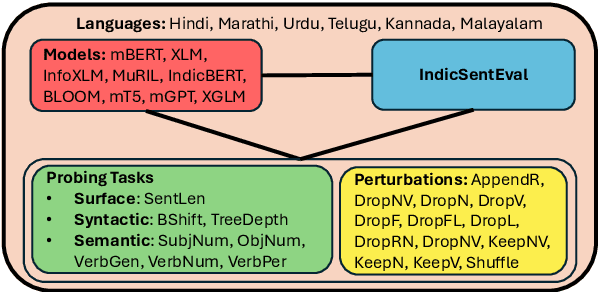
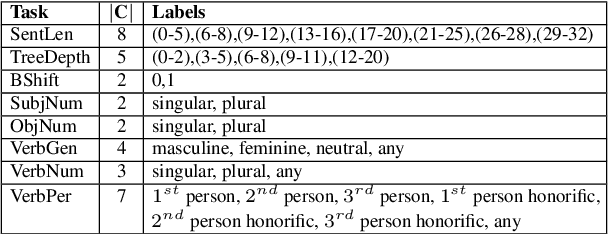
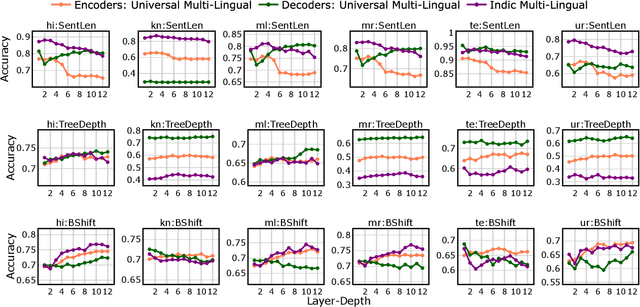
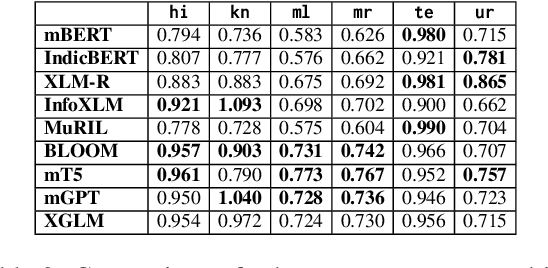
Abstract:Transformer-based models have revolutionized the field of natural language processing. To understand why they perform so well and to assess their reliability, several studies have focused on questions such as: Which linguistic properties are encoded by these models, and to what extent? How robust are these models in encoding linguistic properties when faced with perturbations in the input text? However, these studies have mainly focused on BERT and the English language. In this paper, we investigate similar questions regarding encoding capability and robustness for 8 linguistic properties across 13 different perturbations in 6 Indic languages, using 9 multilingual Transformer models (7 universal and 2 Indic-specific). To conduct this study, we introduce a novel multilingual benchmark dataset, IndicSentEval, containing approximately $\sim$47K sentences. Surprisingly, our probing analysis of surface, syntactic, and semantic properties reveals that while almost all multilingual models demonstrate consistent encoding performance for English, they show mixed results for Indic languages. As expected, Indic-specific multilingual models capture linguistic properties in Indic languages better than universal models. Intriguingly, universal models broadly exhibit better robustness compared to Indic-specific models, particularly under perturbations such as dropping both nouns and verbs, dropping only verbs, or keeping only nouns. Overall, this study provides valuable insights into probing and perturbation-specific strengths and weaknesses of popular multilingual Transformer-based models for different Indic languages. We make our code and dataset publicly available [https://tinyurl.com/IndicSentEval}].
USDC: A Dataset of $\underline{U}$ser $\underline{S}$tance and $\underline{D}$ogmatism in Long $\underline{C}$onversations
Jun 24, 2024Abstract:Identifying user's opinions and stances in long conversation threads on various topics can be extremely critical for enhanced personalization, market research, political campaigns, customer service, conflict resolution, targeted advertising, and content moderation. Hence, training language models to automate this task is critical. However, to train such models, gathering manual annotations has multiple challenges: 1) It is time-consuming and costly; 2) Conversation threads could be very long, increasing chances of noisy annotations; and 3) Interpreting instances where a user changes their opinion within a conversation is difficult because often such transitions are subtle and not expressed explicitly. Inspired by the recent success of large language models (LLMs) for complex natural language processing (NLP) tasks, we leverage Mistral Large and GPT-4 to automate the human annotation process on the following two tasks while also providing reasoning: i) User Stance classification, which involves labeling a user's stance of a post in a conversation on a five-point scale; ii) User Dogmatism classification, which deals with labeling a user's overall opinion in the conversation on a four-point scale. The majority voting on zero-shot, one-shot, and few-shot annotations from these two LLMs on 764 multi-user Reddit conversations helps us curate the USDC dataset. USDC is then used to finetune and instruction-tune multiple deployable small language models for the 5-class stance and 4-class dogmatism classification tasks. We make the code and dataset publicly available [https://anonymous.4open.science/r/USDC-0F7F].
Speech language models lack important brain-relevant semantics
Nov 08, 2023
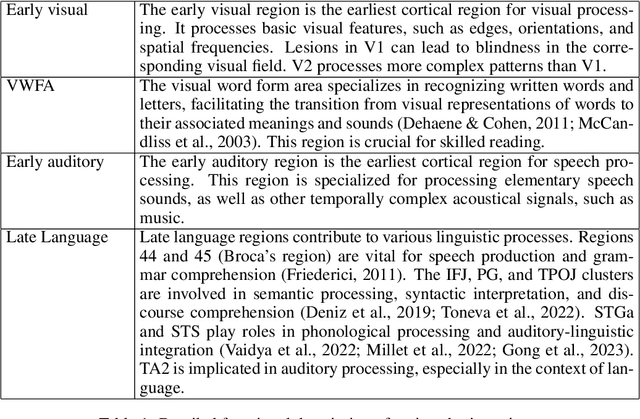
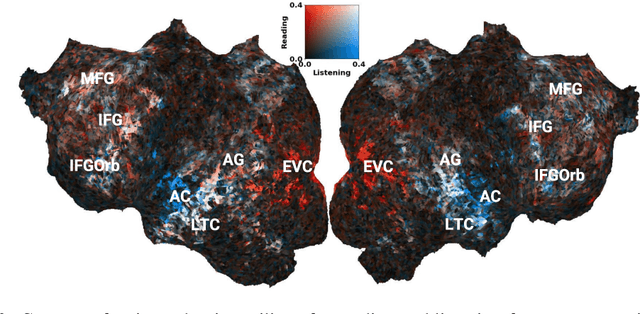
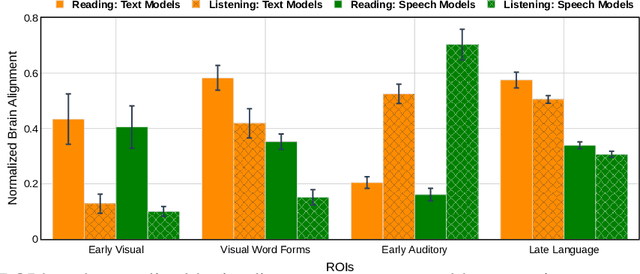
Abstract:Despite known differences between reading and listening in the brain, recent work has shown that text-based language models predict both text-evoked and speech-evoked brain activity to an impressive degree. This poses the question of what types of information language models truly predict in the brain. We investigate this question via a direct approach, in which we eliminate information related to specific low-level stimulus features (textual, speech, and visual) in the language model representations, and observe how this intervention affects the alignment with fMRI brain recordings acquired while participants read versus listened to the same naturalistic stories. We further contrast our findings with speech-based language models, which would be expected to predict speech-evoked brain activity better, provided they model language processing in the brain well. Using our direct approach, we find that both text-based and speech-based language models align well with early sensory regions due to shared low-level features. Text-based models continue to align well with later language regions even after removing these features, while, surprisingly, speech-based models lose most of their alignment. These findings suggest that speech-based models can be further improved to better reflect brain-like language processing.
Deep Neural Networks and Brain Alignment: Brain Encoding and Decoding (Survey)
Jul 17, 2023



Abstract:How does the brain represent different modes of information? Can we design a system that automatically understands what the user is thinking? Such questions can be answered by studying brain recordings like functional magnetic resonance imaging (fMRI). As a first step, the neuroscience community has contributed several large cognitive neuroscience datasets related to passive reading/listening/viewing of concept words, narratives, pictures and movies. Encoding and decoding models using these datasets have also been proposed in the past two decades. These models serve as additional tools for basic research in cognitive science and neuroscience. Encoding models aim at generating fMRI brain representations given a stimulus automatically. They have several practical applications in evaluating and diagnosing neurological conditions and thus also help design therapies for brain damage. Decoding models solve the inverse problem of reconstructing the stimuli given the fMRI. They are useful for designing brain-machine or brain-computer interfaces. Inspired by the effectiveness of deep learning models for natural language processing, computer vision, and speech, recently several neural encoding and decoding models have been proposed. In this survey, we will first discuss popular representations of language, vision and speech stimuli, and present a summary of neuroscience datasets. Further, we will review popular deep learning based encoding and decoding architectures and note their benefits and limitations. Finally, we will conclude with a brief summary and discussion about future trends. Given the large amount of recently published work in the `computational cognitive neuroscience' community, we believe that this survey nicely organizes the plethora of work and presents it as a coherent story.
On Robustness of Finetuned Transformer-based NLP Models
May 23, 2023



Abstract:Transformer-based pretrained models like BERT, GPT-2 and T5 have been finetuned for a large number of natural language processing (NLP) tasks, and have been shown to be very effective. However, while finetuning, what changes across layers in these models with respect to pretrained checkpoints is under-studied. Further, how robust are these models to perturbations in input text? Does the robustness vary depending on the NLP task for which the models have been finetuned? While there exists some work on studying robustness of BERT finetuned for a few NLP tasks, there is no rigorous study which compares this robustness across encoder only, decoder only and encoder-decoder models. In this paper, we study the robustness of three language models (BERT, GPT-2 and T5) with eight different text perturbations on the General Language Understanding Evaluation (GLUE) benchmark. Also, we use two metrics (CKA and STIR) to quantify changes between pretrained and finetuned language model representations across layers. GPT-2 representations are more robust than BERT and T5 across multiple types of input perturbation. Although models exhibit good robustness broadly, dropping nouns, verbs or changing characters are the most impactful. Overall, this study provides valuable insights into perturbation-specific weaknesses of popular Transformer-based models which should be kept in mind when passing inputs.
Syntactic Structure Processing in the Brain while Listening
Feb 16, 2023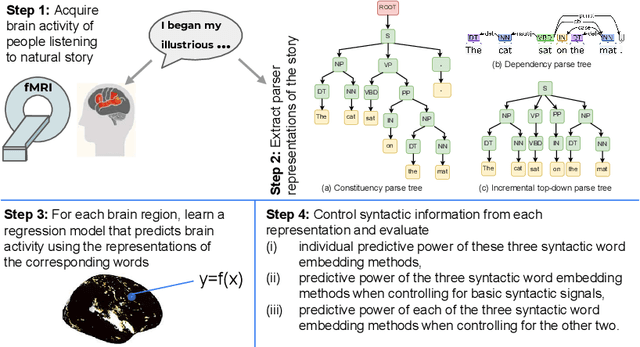
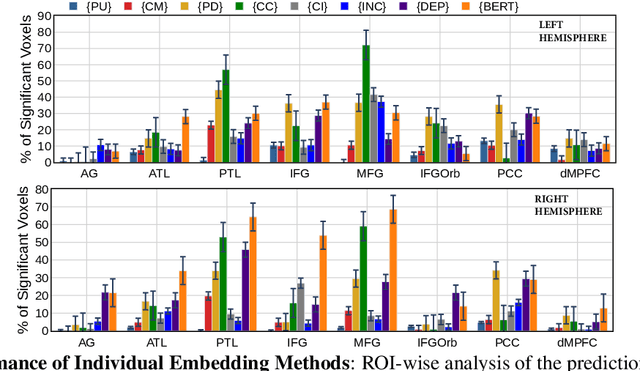
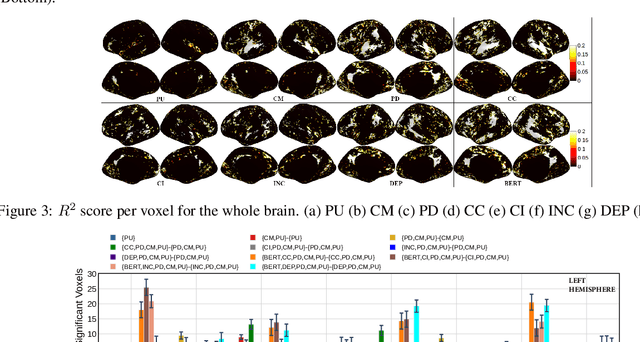
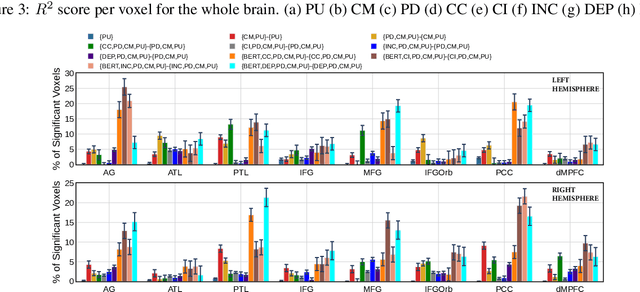
Abstract:Syntactic parsing is the task of assigning a syntactic structure to a sentence. There are two popular syntactic parsing methods: constituency and dependency parsing. Recent works have used syntactic embeddings based on constituency trees, incremental top-down parsing, and other word syntactic features for brain activity prediction given the text stimuli to study how the syntax structure is represented in the brain's language network. However, the effectiveness of dependency parse trees or the relative predictive power of the various syntax parsers across brain areas, especially for the listening task, is yet unexplored. In this study, we investigate the predictive power of the brain encoding models in three settings: (i) individual performance of the constituency and dependency syntactic parsing based embedding methods, (ii) efficacy of these syntactic parsing based embedding methods when controlling for basic syntactic signals, (iii) relative effectiveness of each of the syntactic embedding methods when controlling for the other. Further, we explore the relative importance of syntactic information (from these syntactic embedding methods) versus semantic information using BERT embeddings. We find that constituency parsers help explain activations in the temporal lobe and middle-frontal gyrus, while dependency parsers better encode syntactic structure in the angular gyrus and posterior cingulate cortex. Although semantic signals from BERT are more effective compared to any of the syntactic features or embedding methods, syntactic embedding methods explain additional variance for a few brain regions.
GAE-ISumm: Unsupervised Graph-Based Summarization of Indian Languages
Dec 25, 2022Abstract:Document summarization aims to create a precise and coherent summary of a text document. Many deep learning summarization models are developed mainly for English, often requiring a large training corpus and efficient pre-trained language models and tools. However, English summarization models for low-resource Indian languages are often limited by rich morphological variation, syntax, and semantic differences. In this paper, we propose GAE-ISumm, an unsupervised Indic summarization model that extracts summaries from text documents. In particular, our proposed model, GAE-ISumm uses Graph Autoencoder (GAE) to learn text representations and a document summary jointly. We also provide a manually-annotated Telugu summarization dataset TELSUM, to experiment with our model GAE-ISumm. Further, we experiment with the most publicly available Indian language summarization datasets to investigate the effectiveness of GAE-ISumm on other Indian languages. Our experiments of GAE-ISumm in seven languages make the following observations: (i) it is competitive or better than state-of-the-art results on all datasets, (ii) it reports benchmark results on TELSUM, and (iii) the inclusion of positional and cluster information in the proposed model improved the performance of summaries.
 Add to Chrome
Add to Chrome Add to Firefox
Add to Firefox Add to Edge
Add to Edge